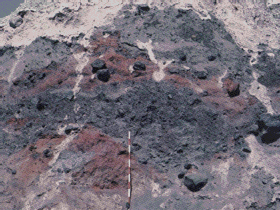| Measurement of Friction Coefficient on a Powder Layer and Fluid Dynamic Study |
|
It is extremely difficult to explain that small coefficient if we assume that the sliding blocks is in direct contact with the ground surface. Can it be that some other materials exist and to make the coefficient small? Ui (1987) pointed out that debris avalanche deposits characteristically have a debris-avalanche matrix, which exists around blocks (Fig. 2). Because the avalanche runs so fast, this matrix could be fluidized while the debris avalanche was running. In this paper, we assume that the existence of this matrix is essential for low friction of the debris avalanche. Based on this point of view, a friction coefficient of a sliding disk on a powder layer was measured and its fluid dynamical discussion was made. |
 Fig. 2. Structure of debris-avalanche deposit of Mt. St. Helens. |
Of course, actual debris avalanches are not so simple; for example, the matrix might be produced by the block grinding on the ground surface when it is running, but we do not know much about mechanism of the powder flow even for such a simple case. Some previous experimental or numerical works (Davies, 1981; Campbell et al., 1995) have been performed on debris avalanches but all of them simply treated the entire avalanche as grain or powder flow. The present work is the first case where the existence of large blocks are considered.